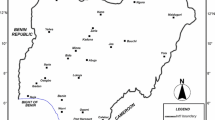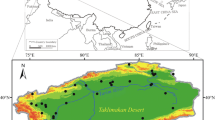Summary
Daily precipitation affinity areas are established for Wales by means of S-mode Principal Components Analysis (PCA) and Cluster Analysis, using data for the autumn-winter (September-January) period, 1982–87, subset according to surface wind direction. Relatively strong PCA simple structures were found for five wind directions clockwise from south to north, using the OBLIMIN rotation for the first four (south to northwest) and the VARIMAX rotation for the last (north). Whilst interpretation of many of the most significant Prinicipal Components (PCs) was difficult in strictly meteorological or climatological terms, the precipitation areas produced by clustering based on the most important PCs, yielded a continuum of change in areal organisation with progressively changing wind direction. Only the far southwest and northwest of the country appear in every area map, although superficially, northeastern, English border and southeastern areas were present on most. The derived areas bear only small overall resemblance to currently used forecasting areas.
Similar content being viewed by others
References
Bärring, L., 1987: Spatial patterns of daily rainfall in central Kenya: application of principal component analysis, common factor analysis and spatial correlation.J. Climatol. 7(3), 267–290.
Bärring, L., 1988: Regionalization of daily rainfall in Kenya by means of common factor analysis.J. Climatol. 8(4), 371–390.
Betts, N. L., 1989: A synoptic climatology of rainfall in Northern Ireland. Unpub. PhD thesis, Queen's Univ., Belfast.
Blumen, W., (ed.) 1990:Atmospheric Processes over Complex Terrain. Meteorological Monographs No. 45, Boston, Mass.: Amer. Meteor. Soc., 323 pp.
Bonell, M., Sumner, G. N., 1992: Autumn—winter daily precipitation areas in Wales: 1982/3 to 1986/7.Int. J. Clim. 12(1), 77–102.
Cattell, R. B., 1966: The scree test for the number of factors.Mult. Behav. Res. 1, 245–276.
Dyer, T. G. J., 1975: The assignment of rainfall stations into homogeneous groups: an application of principal component analysis.Quart. J. Roy. Meteor. Soc. 101, 1005–1013.
Eklundh, L., Pilesjo, P., 1990: Regionalization and spatial estimation of Ethiopian mean annual rainfall.Int. J. Clim. 10(5), 473–494.
Gregory, S., 1975: On the delimitation of regional patterns of recent climatic fluctuations.Weather 30(9), 276–288.
Jackson, I. J., 1974: Inter-station rainfall correlation under tropical conditions.Catena 1, 235–256.
Jolliffe, I. T., 1987: Rotation of principal components: some comments.J. Climatol. 7(5), 507–510.
Lamb, H. H., 1972: British Isles weather types and a register of the daily sequence of circulation patterns, 1861–1971, Meteorological Office, Geophysical Memoir, 116, HMSO, London.
Legates, D. R., 1991: The effect of domain shape on principal components analysis.Int. J. Clim. 11(2), 135–146.
Lowndes, C. A. S., 1968: Forecasting large 24-hour rainfall totals in the Dee and Clwyd River Authority area from September to February.Meteor. Magazine 97, 226–235.
May, B. R., 1984: Reduction in the daily precipitation gauge network in England and Wales.Meteor. Magazine 113(1340), 57–61.
Morgan, R. P. C., 1971: Rainfall of Western Malaysia — a preliminary regionalisation using principal components analysis.Area 3, 222–227.
Ogallo, L. J., 1980: Regional classification of East African rainfall stations into homogeneous groups using the method of prinicipal component analysis. In: Ikeda, S. et al. (eds.)Statistical Climatology. (Devel. in Atmos. Sci., 13) Amsterdam: Elsevier.
Ogallo, L. J., 1989: The spatial and temporal patterns of the East African seasonal rainfall derived from prinicipal components analysis.Int. J. Clim. 9, 145–167.
Pandzic, K., 1988: Principal component analysis of rainfall in the Adriatic-Pannonian area of Yugoslavia.Int. J. Clim. 8(4), 357–370.
Pedgley, D. E., 1970: Heavy rainfalls over Snowdonia.Weather 25, 340–350.
Pedgley, D. E., 1971: Some weather patterns in Snowdonia.Weather 26, 412–444.
Richman, M. B., 1986: Rotation of principal components.J. Climatol. 6, 293–335.
Richman, M. B., 1987: Rotation of principal components: a reply.J. Climatol. 7(5), 511–520.
Rummel, R. J., 1970:Applied Factor Analysis. Evanston Northwestern University Press, 617 pp.
Singleton, F., Spackman, E. A., 1984: Climatological network design.Meteor. Magazine 113, 77–89.
Spackman, E. A., Singleton, F., 1982: Recent developments in the quality control of climatological data.Meteor. Magazine. 111(1325), 301–311.
Stone, R. C., 1989: Weather types at Brisbane, Queensland: an example of the use of principal components and cluster analysis.Int. J. Clim. 9(1), 3–32.
Sumner, G. N., 1983: Seasonal changes in the distribution of rainfall over the great dividing range: general trends.Austr. Meteor. Magazine 31, 121–130.
Sumner, G. N., Bonell, M., 1988: Variation in the spatial organisation of daily rainfall during the North Queensland wet season.Theor. Appl. Climatol. 39(2), 59–74.
Sumner, G. N., Bonell, M., 1990: The spatial organisation of daily rainfall in Wales, during the autumn-winter.Weather 45(5), 174–183.
Tabony, R. C., 1981: A principal component and spectral analysis of European Rainfall.J. Clim. 1(3), 283–294.
Ward, J. H., 1963: Hierarchical grouping to optimize an objective function.Amer. Sci. Assoc. Journ. 58, 236–244.
Wigley, T. M. L., Lough, J. M., Jones, P. D., 1984: Spatial patterns of precipitation in England and Wales and a revised heteorogeneous England and Wales precipitation series.J. Clim. 4, 1–25.
Willmott, C. J., 1978: P-mode principal components analysis, grouping and rainfall regions in California.Arch. Met. Geoph. Biokl., Ser. B. 26, 277.
Author information
Authors and Affiliations
Additional information
With 9 Figures
Rights and permissions
About this article
Cite this article
Bonell, M., Sumner, G. Atmospheric circulation and daily precipitation in Wales. Theor Appl Climatol 46, 3–25 (1992). https://doi.org/10.1007/BF00866443
Received:
Revised:
Issue Date:
DOI: https://doi.org/10.1007/BF00866443




